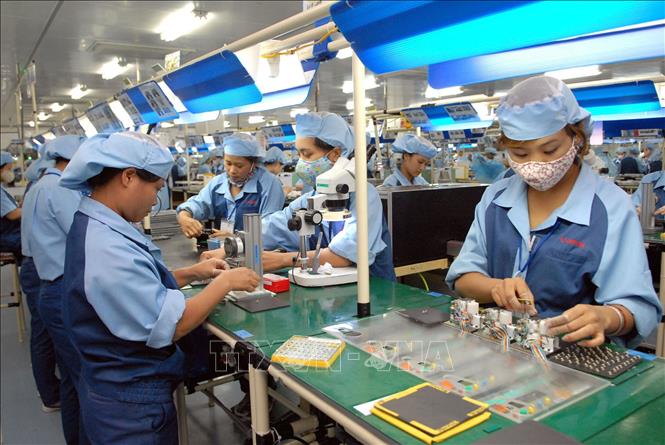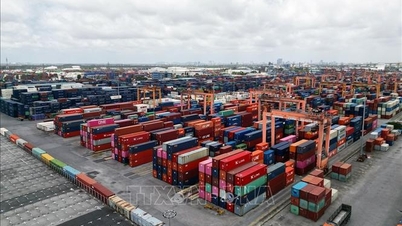
Workers producing electronic components at Canon Electronics Co., Ltd. (Pho Noi A Industrial Park, Hung Yen province). Photo: Pham Kien/TTXVN
According to a report by the Vietnam News Agency correspondent in Paris, citing the aforementioned magazine, Vietnam, along with India, Indonesia, Mexico, and Saudi Arabia, is becoming a new engine of global growth as traditional economic powers in the North gradually slow down.
From an economy primarily based on textiles, Vietnam has rapidly risen to become a global manufacturing hub – specifically, an assembly center – primarily serving Western markets. This transformation is based on solid foundations: a continuously strong increase in foreign direct investment, a young and increasingly skilled workforce of nearly 55 million people, competitive production costs, and a strategic position in the global supply chain.
As a result, Vietnam's export turnover has increased rapidly, currently reaching nearly 450 billion USD per year. Per capita income has also increased nearly fourfold compared to the late 1990s. Vietnam is considered one of the countries that has benefited most from the globalization process, and is gradually asserting its central role in the global production network of the 21st century.
Along with Vietnam, India is leading the group of emerging economies with the highest growth rate in the world in 2025. This growth is driven by a young population, an increasingly skilled workforce, and enhanced productivity thanks to strong investment in infrastructure and digital transformation. With over 1.4 billion people, India has surpassed China to become the world's most populous country, while simultaneously building a "digital empire" with widespread influence across its economy.
In Southeast Asia, Indonesia is emerging as a regional powerhouse. With a population of 285 million, nearly 70% of whom are of working age, the country is effectively leveraging its "demographic dividend." As the world's largest producer of nickel, and possessing abundant reserves of coal, copper, and bauxite, Indonesia has oriented its development towards an industrialization model based on deep processing, thereby attracting capital and technology to increase added value.
Across the Pacific, Mexico asserts its position as the industrial hub of the Americas. Its proximity to the U.S., free trade agreements, and abundant workforce have made Mexico the "factory" of North America. However, with 81% of its exports destined for the U.S., the country remains heavily influenced by Washington's trade policies.
In the Middle East, Saudi Arabia is gradually moving away from its oil-dependent economic model through its "Vision 2030" program. This policy aims to develop new industries, attract foreign investment, and build a more diversified and dynamic economy.
According to Xerfi Canal, the center of global growth is gradually shifting from North to South. While Washington, Beijing, and Berlin were previously considered the main engines of the global economy, New Delhi, Jakarta, Hanoi, Mexico City, and Riyadh are now emerging as new centers of global economic dynamism in the post-industrial era.
Source: https://baotintuc.vn/kinh-te/viet-nam-diem-sang-trong-lan-song-tang-truong-moi-20251101064131171.htm



![[Photo] Prime Minister Pham Minh Chinh receives the Governor of Tochigi Province (Japan)](/_next/image?url=https%3A%2F%2Fvphoto.vietnam.vn%2Fthumb%2F1200x675%2Fvietnam%2Fresource%2FIMAGE%2F2025%2F12%2F16%2F1765892133176_dsc-8082-6425-jpg.webp&w=3840&q=75)
![[Image] Leaked images ahead of the 2025 Community Action Awards gala.](/_next/image?url=https%3A%2F%2Fvphoto.vietnam.vn%2Fthumb%2F1200x675%2Fvietnam%2Fresource%2FIMAGE%2F2025%2F12%2F16%2F1765882828720_ndo_br_thiet-ke-chua-co-ten-45-png.webp&w=3840&q=75)
![[Image] The tenacious fighting spirit of Vietnamese women's football](/_next/image?url=https%3A%2F%2Fvphoto.vietnam.vn%2Fthumb%2F1200x675%2Fvietnam%2Fresource%2FIMAGE%2F2025%2F12%2F17%2F1765990260956_ndo_br_4224760955870434771-copy-jpg.webp&w=3840&q=75)
![[Live] 2025 Community Action Awards Gala](/_next/image?url=https%3A%2F%2Fvphoto.vietnam.vn%2Fthumb%2F1200x675%2Fvietnam%2Fresource%2FIMAGE%2F2025%2F12%2F16%2F1765899631650_ndo_tr_z7334013144784-9f9fe10a6d63584c85aff40f2957c250-jpg.webp&w=3840&q=75)
![[Photo] Prime Minister Pham Minh Chinh receives Lao Minister of Education and Sports Thongsalith Mangnormek](/_next/image?url=https%3A%2F%2Fvphoto.vietnam.vn%2Fthumb%2F1200x675%2Fvietnam%2Fresource%2FIMAGE%2F2025%2F12%2F16%2F1765876834721_dsc-7519-jpg.webp&w=3840&q=75)







































































![[Live] Closing Ceremony and Award Presentation for the "Impressive Vietnam Tourism" Video/Clip Creation Contest 2025](https://vphoto.vietnam.vn/thumb/402x226/vietnam/resource/IMAGE/2025/12/17/1765974650260_z7273498850699-00d2fd6b0972cb39494cfa2559bf85ac-1765959338756946072104-627-0-1338-1138-crop-1765959347256801551121.jpeg)
























Comment (0)